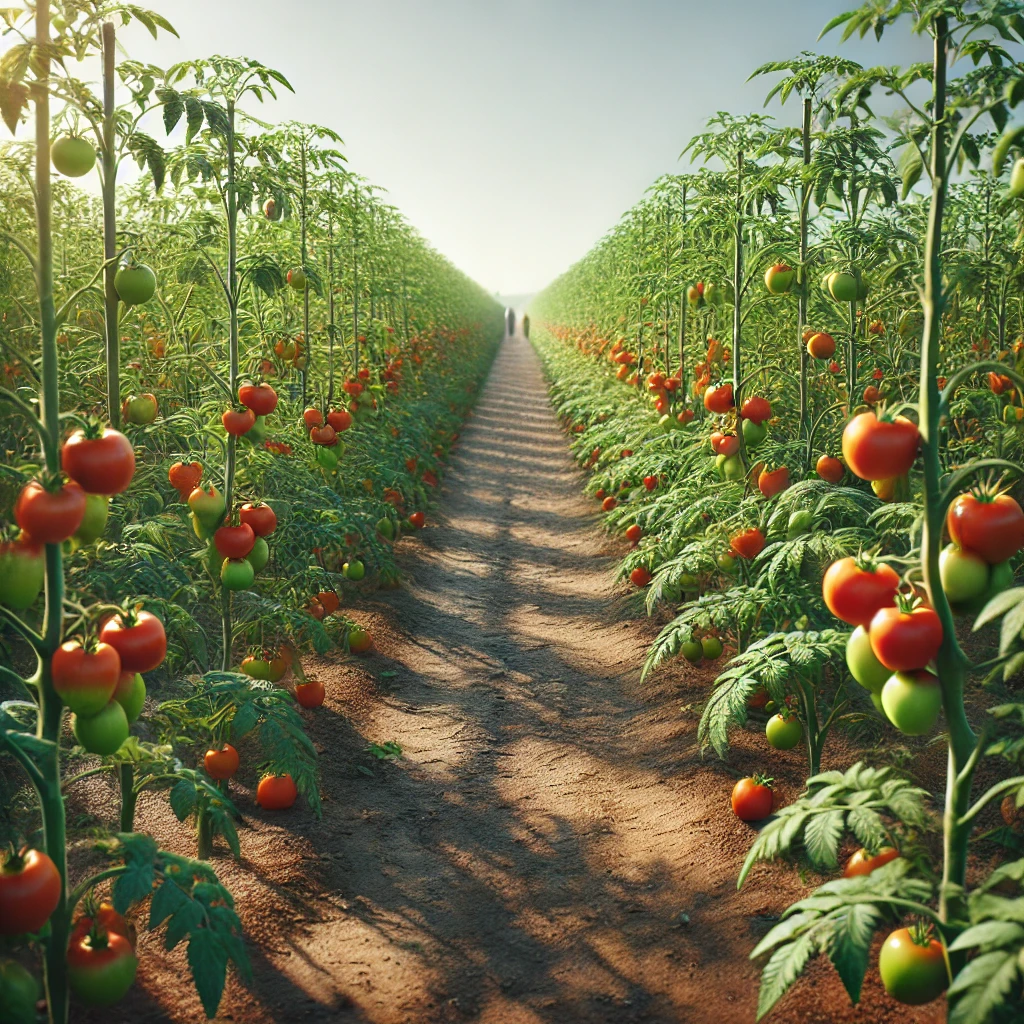Introduction
Few foods capture the imagination and palate as vividly as the tomato, a vibrant fruit often mistaken for a vegetable, which has woven itself into the fabric of cuisines worldwide. Originating in the highlands of western South America, the tomato (Solanum lycopersicum) journeyed from obscurity to global prominence, transforming diets, economies, and cultures. Its juicy flesh, ranging from ruby red to golden yellow, delivers a unique blend of sweet, tart, and umami flavors, making it indispensable in dishes from Italian marinara to Mexican salsa. Beyond its culinary allure, the tomato offers rich nutritional benefits, packed with vitamins, antioxidants, and minerals that support human health. Cultivated on every continent except Antarctica, tomatoes thrive in diverse climates, with global production exceeding 180 million metric tons annually. They sustain millions of farmers, fuel international trade, and inspire culinary innovation, from heirloom varieties to genetically modified strains. Yet, the tomato’s rise has not been without challenges, including environmental concerns and debates over industrial farming practices. This article explores the tomato’s remarkable history, nutritional properties, cultivation methods, and multifaceted uses, concluding with reflections on its future in a rapidly changing world. Through this journey, we uncover why the tomato remains a cornerstone of global cuisine and a symbol of agricultural ingenuity.
As we delve into the tomato’s past, its origins reveal a story of discovery and transformation that reshaped human diets.

History of the Tomato
Origins in South America
The tomato’s story begins in the rugged Andes of western South America, likely in modern-day Peru and Ecuador, where wild ancestors of Solanum lycopersicum grew as small, cherry-like fruits. Archaeological evidence suggests these wild tomatoes were harvested by indigenous peoples as early as 700 AD, though cultivation likely began later. The fruit, initially bitter and green, was domesticated by Mesoamerican cultures, particularly in Mexico, where the Aztecs cultivated it by the 15th century. They called it xitomatl, meaning “plump fruit with a navel,” distinguishing it from the husk-covered tomatillo. These early tomatoes, yellow or red and the size of modern grape tomatoes, were prized for their flavor and used in sauces and stews, often paired with chilies and maize.
Domestication involved selecting plants with larger, sweeter fruits, a process that transformed the tomato’s size and taste. By the time Spanish conquistadors arrived in the early 16th century, tomatoes were a staple in Aztec cuisine, grown alongside beans and squash in milpa systems. The Spanish, intrigued by this novel fruit, brought tomato seeds to Europe around 1520, marking the start of its global journey.
Spread to Europe and Beyond
The tomato’s arrival in Europe was met with curiosity and suspicion. Initially grown as an ornamental plant in Spain and Italy, it was dubbed pomo d’oro (golden apple) in Italian, reflecting early yellow varieties. Many Europeans feared it was poisonous, as it belongs to the nightshade family (Solanaceae), which includes toxic plants like belladonna. This misconception persisted into the 18th century, delaying its culinary adoption. In Spain, however, tomatoes were embraced earlier, appearing in recipes by the late 16th century, often stewed with olive oil and herbs.
By the 17th century, tomatoes spread to France, England, and the Mediterranean, aided by trade and colonial networks. Italian cooks began using them in sauces, laying the foundation for modern pasta dishes. The tomato reached Asia via Portuguese traders, arriving in the Philippines by the 16th century and later China and India. In North America, tomatoes were reintroduced by European settlers, though widespread acceptance lagged until the 19th century, when recipes for ketchup and tomato soup emerged.
Cultural Integration and Industrialization
The 19th century marked the tomato’s global triumph. In the United States, Italian immigrants popularized tomato-based dishes, while canning technology, pioneered by companies like Heinz, made tomatoes accessible year-round. By 1880, canned tomatoes and ketchup were pantry staples, with production soaring. The invention of pizza in Naples, topped with tomato sauce, cemented the fruit’s culinary status. In India, tomatoes became integral to curries, blending with spices to create dishes like rogan josh.
The 20th century saw the tomato’s industrialization. Breeding programs developed high-yielding, disease-resistant varieties, boosting output but often at the cost of flavor. The rise of processed foods—sauces, pastes, and juices—further embedded tomatoes in global diets. Today, tomatoes are a cultural icon, celebrated in festivals like Spain’s La Tomatina, where thousands hurl tomatoes in a vibrant spectacle.
Modern Challenges and Heirloom Revival
Modern tomato production faces scrutiny. Industrial farming prioritizes yield and shelf life, leading to bland, uniform fruits. Genetic modification, introduced in the 1990s with the Flavr Savr tomato, aimed to extend freshness but sparked consumer backlash over taste and safety. Meanwhile, heirloom varieties—open-pollinated strains preserved by farmers—have surged in popularity, prized for their diverse flavors and colors, from deep purple to striped green.
The tomato’s history reflects its adaptability and cultural resonance. Yet, its nutritional value underscores why it remains a dietary staple.

Nutritional Properties of the Tomato
Macronutrients and Energy
With only about 18 kilocalories per 100 grams, raw tomatoes fit perfectly into weight‑conscious diets. Those same 100 grams deliver roughly 3.9 grams of carbohydrates—mainly glucose and fructose—for a pleasant sweet‑tart taste. A single serving also supplies 1.2 grams of dietary fiber to aid digestion and support heart health, while protein remains modest at 0.9 grams and fat is negligible at 0.2 grams.
Vitamins and Antioxidants
Tomatoes boast an impressive vitamin profile. Fourteen milligrams of vitamin C per 100 grams (about 17 % of the daily value) strengthen immune function and skin health. Beta‑carotene provides 833 IU of vitamin A (17 % DV) to support vision and immunity, and 7.9 µg of vitamin K (10 % DV) assists in proper blood clotting. Smaller quantities of folate (15 µg, 4 % DV) and vitamin E (0.54 mg, 3 % DV) round out their nutrient mix.
Antioxidants are a standout feature. A 100‑gram serving contains around 2.6 mg of lycopene—a potent pigment linked to lower risks of heart disease and certain cancers—and cooking tomatoes increases its bioavailability. Additional compounds like beta‑carotene and chlorogenic acid further combat oxidative stress and protect cells from damage.
Minerals and Other Compounds
Potassium is plentiful at 237 mg per 100 grams (5 % DV), helping regulate blood pressure, while magnesium (11 mg, 3 % DV) and phosphorus (24 mg, 3 % DV) support muscle and bone health. Trace levels of iron, zinc, and manganese contribute to overall wellness. Beyond minerals, flavonoids and phenolic acids add anti‑inflammatory effects that boost the fruit’s health benefits.
Health Considerations
Although tomatoes are generally well tolerated, their acidity can trigger heartburn in sensitive individuals. Those with nightshade sensitivities sometimes report joint discomfort, and oxalates present in small amounts might affect people prone to kidney stones. For most eaters, however, tomatoes remain a safe, nutrient‑dense food.

Cultivation of the Tomato
Climate and Soil Requirements
Tomatoes thrive in warm, sunny climates, requiring temperatures between 18°C and 27°C for optimal growth. They need at least six hours of direct sunlight daily and are sensitive to frost, which can kill young plants. Rainfall of 600–1,500 millimeters annually suits them, though irrigation is common in drier regions. Well-drained, loamy soils with a pH of 6.0–6.8 are ideal, rich in organic matter to support root development. Heavy clay or sandy soils require amendments like compost to improve structure.
Varieties and Breeding
Tomato varieties number in the thousands, tailored to climate, use, and taste. Common types include:
Beefsteak: Large, juicy fruits for slicing; ideal for sandwiches.
Cherry: Small, sweet tomatoes for salads and snacking.
Roma: Oval, meaty fruits for sauces and canning.
Heirloom: Diverse, flavorful varieties like Brandywine or Cherokee Purple, grown for taste.
Hybrid: Disease-resistant, high-yielding types like Big Boy for commercial use.
Breeding has focused on yield, pest resistance, and shelf life. The 20th century saw hybrids dominate, but heirlooms are regaining favor for their flavor. Genetic modification, though controversial, has produced varieties with enhanced traits, like delayed ripening.
Farming Practices
Tomato cultivation blends traditional and modern techniques:
Propagation: Seeds are sown in nurseries, then transplanted after 4–6 weeks.
Irrigation: Drip systems conserve water, critical in arid regions.
Fertilization: Nitrogen, phosphorus, and potassium are applied, with calcium to prevent blossom-end rot.
Pest Control: Integrated pest management targets aphids, whiteflies, and fungi like blight.
Support: Staking or caging prevents fruit rot and eases harvesting.
Greenhouses extend growing seasons in colder climates, producing 10–20 tons per hectare compared to 5–10 tons in open fields. Hydroponics, using nutrient-rich water, boosts yields in controlled settings.
Challenges
Tomato farming faces hurdles:
Climate Change: Heatwaves and erratic rains disrupt growth.
Pests and Diseases: Blight, wilt, and insects like tomato hornworms reduce yields.
Sustainability: Heavy pesticide and water use strain ecosystems.
Labor: Hand-harvesting in developing nations raises ethical concerns over worker conditions.
Research into drought-tolerant varieties, organic methods, and precision agriculture aims to address these issues, ensuring tomatoes remain accessible.
The tomato’s cultivation feeds its vast uses, from kitchen staples to industrial products.

Uses of the Tomato
Culinary Applications
Tomatoes are a culinary chameleon, starring in countless dishes. Fresh, they grace salads, sandwiches, and salsas, their juicy texture adding vibrancy. Cooked, they form the backbone of sauces, soups, and stews. Italian marinara, Indian curry, and Mexican mole all rely on tomatoes for depth. Sun-dried tomatoes lend intense flavor to pastas and breads, while tomato paste thickens dishes with concentrated umami.
Processing extends their reach. Canned tomatoes, juices, and ketchup are pantry essentials, with global ketchup consumption topping 190 million tons annually. Tomato powder seasons snacks, and fermented tomato sauces, like Southeast Asian sambals, add zest.
Non-Culinary Uses
Tomatoes have surprising non-food roles:
Cosmetics: Lycopene and vitamins in tomato extracts nourish skin in creams and masks.
Animal Feed: Tomato pomace, a by-product of juicing, feeds livestock.
Industrial: Tomato seeds yield oil for soaps and lubricants; skins are explored for biodegradable films.
Traditional Medicine: In some cultures, tomato poultices soothe burns, though evidence is limited.
Emerging Applications
Innovation is expanding tomato uses. Tomato-based bioplastics, derived from skin polysaccharides, are being developed for packaging, offering a compostable alternative to plastic. In biotechnology, tomatoes are engineered to produce vaccines or proteins, with trials for edible vaccines underway. Tomato extracts in nutraceuticals target heart health, capitalizing on lycopene’s antioxidant power.
The tomato’s versatility ensures its enduring relevance, but its future hinges on overcoming modern challenges.

Leave a Reply